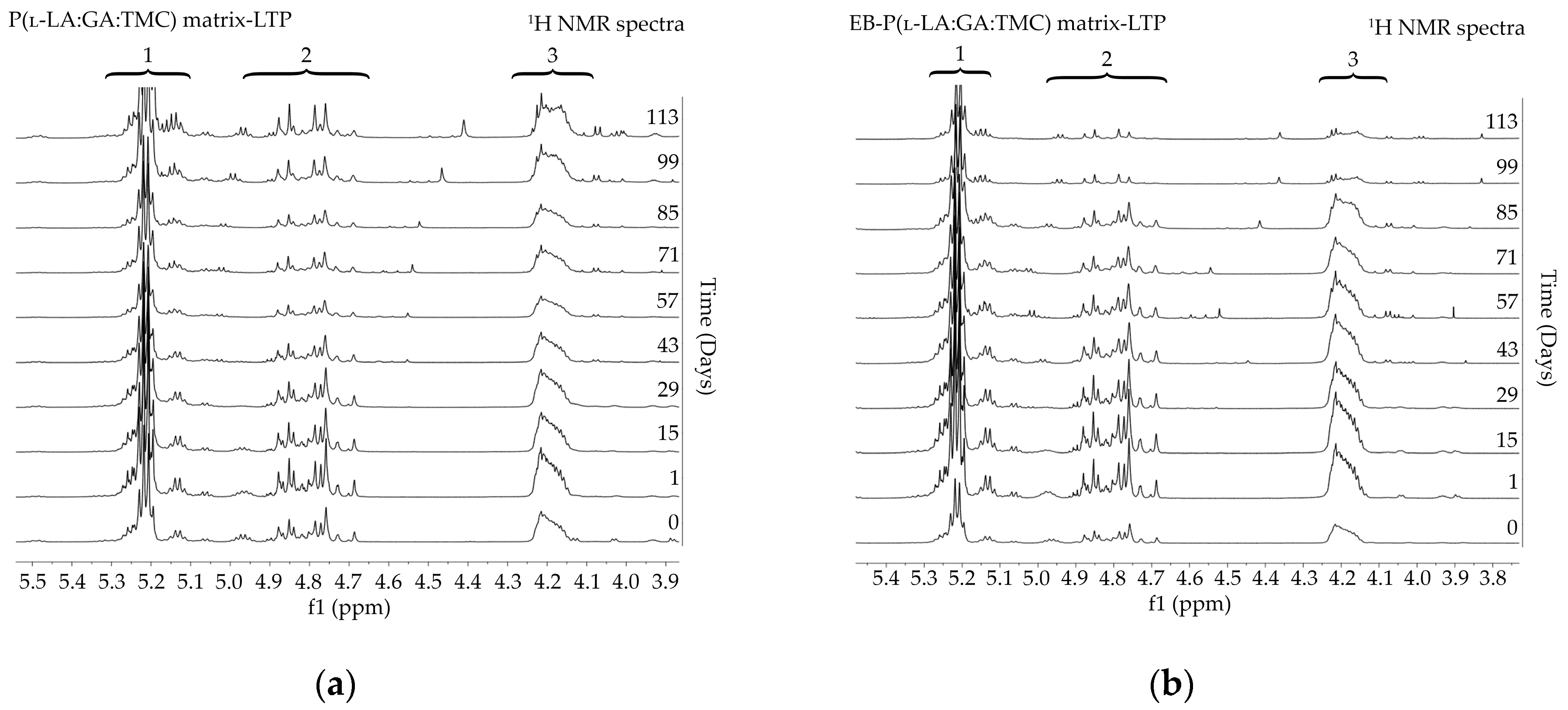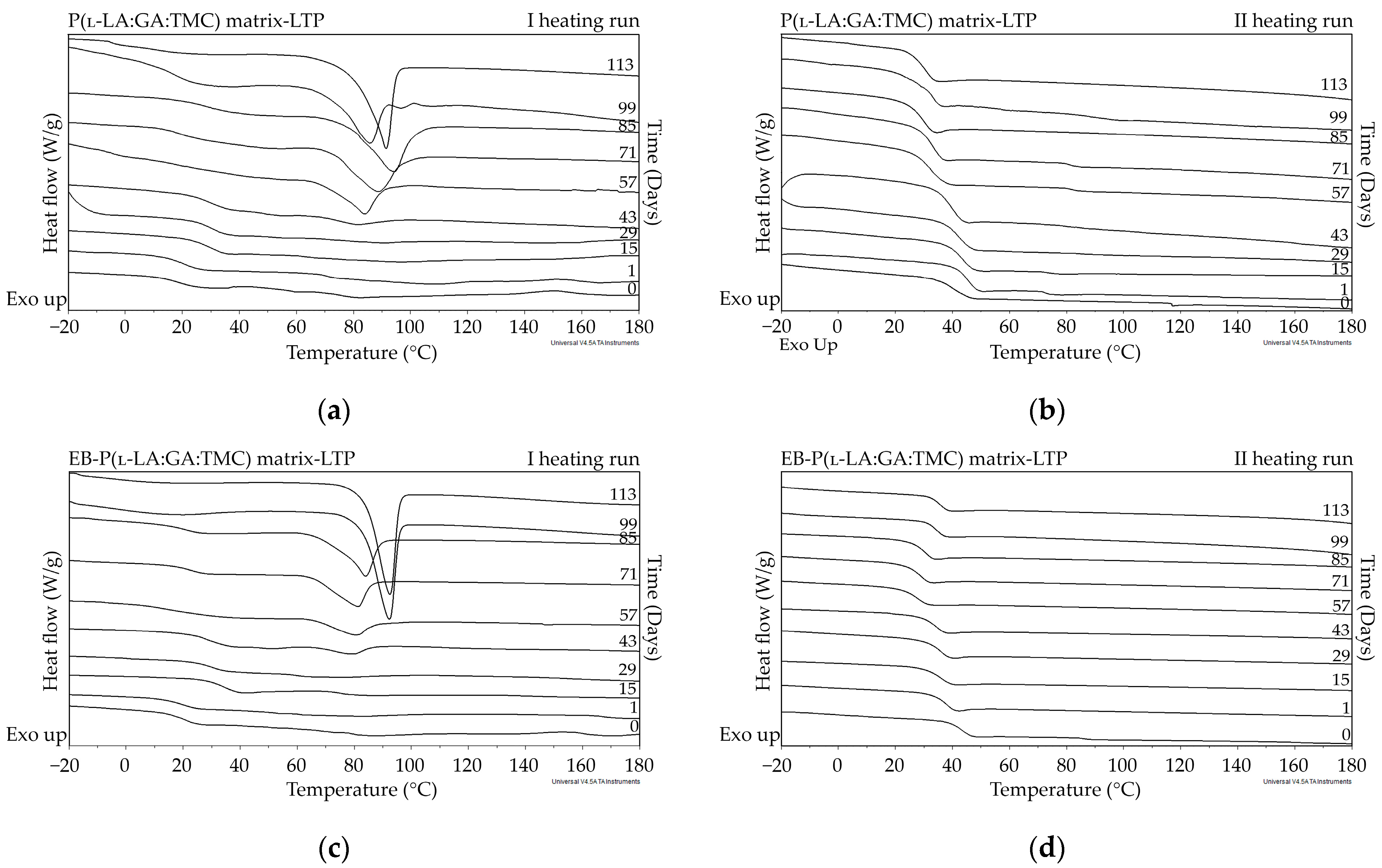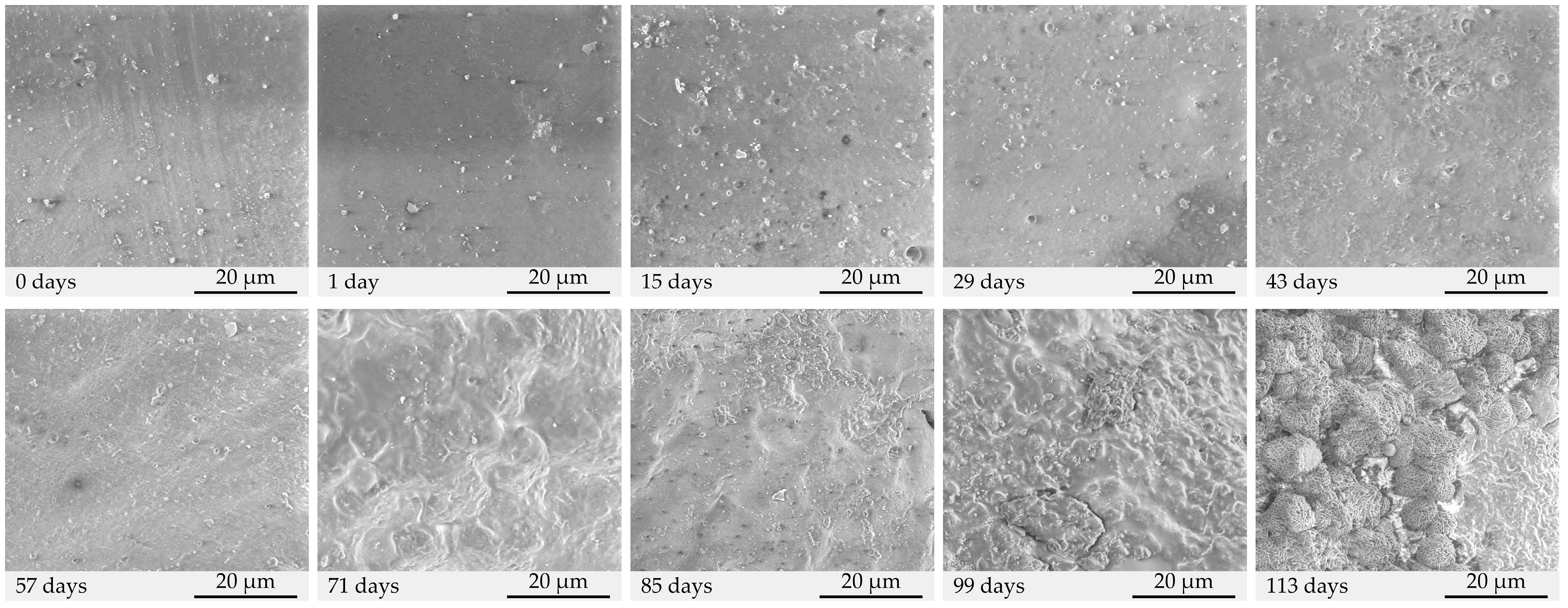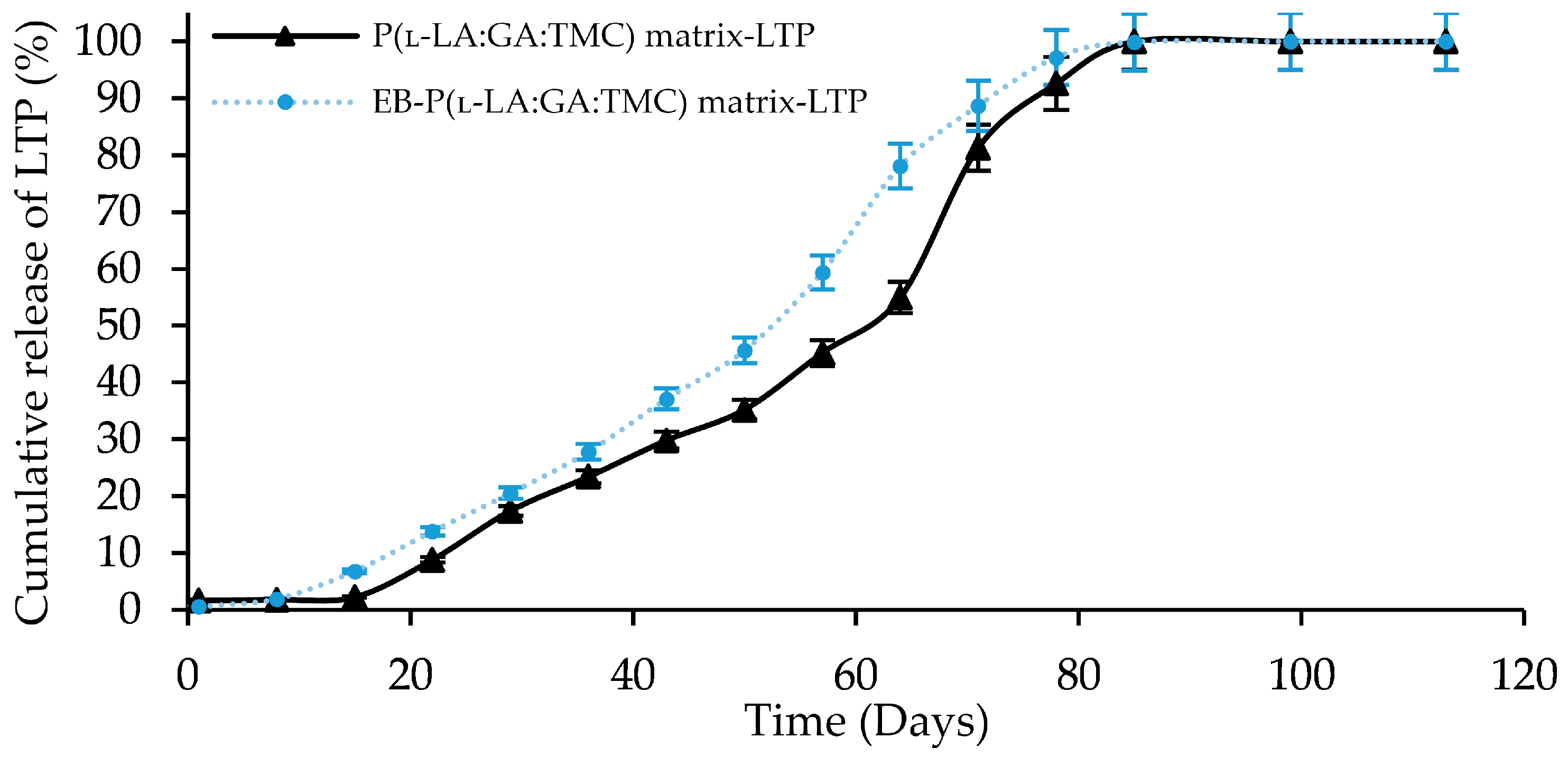Development of the Latanoprost Solid Delivery System Based on Poly(l-lactide-co-glycolide-co-trimethylene carbonate) with Shape Memory for Glaucoma Treatment
Abstract
1. Introduction
2. Materials and Methods
2.1. Terpolymer Synthesis
2.2. Matrices Formulation
2.3. Matrix Degradation
2.4. Terpolymer Composition Study
2.5. LTP Loading Efficiency Study
2.6. Thermal Study
2.7. Molecular Weight and Molecular Weight Distribution Studies
2.8. Water Uptake and Weight Loss Studies
2.9. Morphology Study
2.10. LTP Release
3. Results and Discussion
4. Conclusions
Author Contributions
Funding
Institutional Review Board Statement
Informed Consent Statement
Data Availability Statement
Conflicts of Interest
References
- Toris, C.B.; Gabelt, B.T.; Kaufman, P.L. Update on the mechanism of action of topical prostaglandins for intraocular pressure reduction. Surv. Ophthalmol. 2008, 53 (Suppl. S1), S107–S120. [Google Scholar] [CrossRef]
- Alm, A. Latanoprost in the treatment of glaucoma. Clin. Ophthalmol. 2014, 8, 1967–1985. [Google Scholar]
- Stjernschantz, J.W. From PGF(2alpha)-isopropyl ester to latanoprost: A review of the development of xalatan: The Proctor Lecture. Investig. Ophthalmol. Vis. Sci. 2001, 42, 1134–1145. [Google Scholar]
- Sjöquist, B.; Stjernschantz, J. Ocular and systemic pharmacokinetics of latanoprost in humans. Surv. Ophthalmol. 2002, 47 (Suppl. S1), S6–S12. [Google Scholar] [CrossRef]
- Digiuni, M.; Fogagnolo, P.; Rossetti, L. A review of the use of latanoprost for glaucoma since its launch. Expert Opin. Pharmacother. 2012, 13, 723–745. [Google Scholar] [CrossRef]
- Alm, A.; Camras, C.B.; Watson, P.G. Phase III latanoprost studies in Scandinavia, the United Kingdom and the United States. Surv. Ophthalmol. 1997, 41 (Suppl. S2), S105–S110. [Google Scholar] [CrossRef]
- Johnstone, M.A.; Albert, D.M. Prostaglandin-induced hair growth. Surv. Ophthalmol. 2002, 47 (Suppl. S1), S185–S202. [Google Scholar] [CrossRef]
- Alm, A.; Schoenfelder, J.; McDermott, J. A 5-year, multicenter, open-label, safety study of adjunctive latanoprost therapy for glaucoma. Arch. Ophthalmol. 2004, 122, 957–965. [Google Scholar] [CrossRef]
- Alm, A.; Grunden, J.W.; Kwok, K.K. Five-year, multicenter safety study of fixed-combination latanoprost/timolol (Xalacom) for open-angle glaucoma and ocular hypertension. J. Glaucoma 2011, 20, 215–222. [Google Scholar] [CrossRef]
- Goldberg, I.; Li, X.Y.; Selaru, P.; Paggiarino, D. A 5-year, randomized, open-label safety study of latanoprost and usual care in patients with open-angle glaucoma or ocular hypertension. Eur. J. Ophthalmol. 2008, 18, 408–416. [Google Scholar] [CrossRef]
- Spaeth, G.L. Visual loss in a glaucoma clinic. I. Sociological considerations. Investig. Ophthalmol. 1970, 9, 73–82. [Google Scholar]
- Norell, S.E.; Granström, P.A. Self-medication with pilocarpine among outpatients in a glaucoma clinic. Br. J. Ophthalmol. 1980, 64, 137–141. [Google Scholar] [CrossRef]
- Kass, M.A.; Hodapp, E.; Gordon, M.; Kolker, A.E.; Goldberg, I. Part I. Patient administration of eyedrops: Interview. Ann. Ophthalmol. 1982, 14, 775–779. [Google Scholar]
- Okeke, C.O.; Quigley, H.A.; Jampel, H.D.; Ying, G.S.; Plyler, R.J.; Jiang, Y.; Friedman, D.S. Adherence with topical glaucoma medication monitored electronically the Travatan Dosing Aid study. Ophthalmology 2009, 116, 191–199. [Google Scholar] [CrossRef]
- Sleath, B.; Blalock, S.; Covert, D.; Stone, J.L.; Skinner, A.C.; Muir, K.; Robin, A.L. The relationship between glaucoma medication adherence, eye drop technique, and visual field defect severity. Ophthalmology 2011, 118, 2398–2402. [Google Scholar] [CrossRef]
- Lai, J.-Y.; Luo, L.-J.; Nguyen, D.D. Multifunctional glutathione-dependent hydrogel eye drops with enhanced drug bioavailability for glaucoma therapy. Chem. Eng. J. 2020, 402, 126190. [Google Scholar] [CrossRef]
- Lanier, O.L.; Manfre, M.G.; Bailey, C.; Liu, Z.; Sparks, Z.; Kulkarni, S.; Chauhan, A. Review of approaches for increasing ophthalmic bioavailability for eye drop formulations. AAPS PharmSciTech 2021, 22, 107. [Google Scholar] [CrossRef]
- Zhou, X.; Li, X.; Xu, J.; Cheng, Y.; Cao, F. Latanoprost-loaded cyclodextrin microaggregate suspension eye drops for enhanced bioavailability and stability. Eur. J. Pharm. Sci. 2021, 160, 105758. [Google Scholar] [CrossRef]
- Dang, H.; Dong, C.; Zhang, L. Sustained latanoprost release from PEGylated solid lipid nanoparticle-laden soft contact lens to treat glaucoma. Pharm. Dev. Technol. 2022, 27, 127–133. [Google Scholar] [CrossRef]
- Xu, J.; Ge, Y.; Bu, R.; Zhang, A.; Feng, S.; Wang, J.; Gou, J.; Yin, T.; He, H.; Zhang, Y.; et al. Co-delivery of latanoprost and timolol from micelles-laden contact lenses for the treatment of glaucoma. J. Control. Release 2019, 305, 18–28. [Google Scholar] [CrossRef]
- Horne, R.R.; Rich, J.T.; Bradley, M.W.; Pitt, W.G. Latanoprost uptake and release from commercial contact lenses. J. Biomater. Sci. Polym. Ed. 2020, 31, 1–19. [Google Scholar] [CrossRef]
- Ciolino, J.B.; Stefanescu, C.F.; Ross, A.E.; Salvador-Culla, B.; Cortez, P.; Ford, E.M.; Wymbs, K.A.; Sprague, S.L.; Mascoop, D.R.; Rudina, S.S.; et al. In vivo performance of a drug-eluting contact lens to treat glaucoma for a month. Biomaterials 2014, 35, 432–439. [Google Scholar] [CrossRef]
- Altuntuğ Cesur, M.İ.; Osman, B.; Tümay Özer, E.; Kanmaz, D.; Baykara, M.; Karaca, E. Preparation and characterization of latanoprost-loaded PVA nanofibers as an ocular drug delivery system for glaucoma treatment. Int. J. Polym. Mater. 2023, 1–10. Available online: https://www.tandfonline.com/doi/epdf/10.1080/00914037.2023.2213387?needAccess=true&role=button (accessed on 10 May 2023). [CrossRef]
- Bengani, L.C.; Hsu, K.H.; Gause, S.; Chauhan, A. Contact lenses as a platform for ocular drug delivery. Expert Opin. Drug. Deliv. 2013, 10, 1483–1496. [Google Scholar] [CrossRef]
- Hui, A.; Willcox, M. In vivo studies evaluating the use of contact lenses for drug delivery. Optom. Vis. Sci. 2016, 93, 367–376. [Google Scholar] [CrossRef]
- Cheng, Y.H.; Tsai, T.H.; Jhan, Y.Y.; Chiu, A.W.; Tsai, K.L.; Chien, C.S.; Chiou, S.H.; Liu, C.J. Thermosensitive chitosan-based hydrogel as a topical ocular drug delivery system of latanoprost for glaucoma treatment. Carbohydr. Polym. 2016, 144, 390–399. [Google Scholar] [CrossRef]
- Voss, K.; Falke, K.; Bernsdorf, A.; Grabow, N.; Kastner, C.; Sternberg, K.; Minrath, I.; Eickner, T.; Wree, A.; Schmitz, K.P.; et al. Development of a novel injectable drug delivery system for subconjunctival glaucoma treatment. J. Control. Release 2015, 214, 1–11. [Google Scholar] [CrossRef]
- Fathalla, D.; Fouad, E.A.; Soliman, G.M. Latanoprost niosomes as a sustained release ocular delivery system for the management of glaucoma. Drug Dev. Ind. Pharm. 2020, 46, 806–813. [Google Scholar] [CrossRef]
- Rubenicia, A.M.L.; Cubillan, L.D.P.; Sicam, V.A.D.P.; Macabeo, A.P.G.; Villaflores, O.B.; Castillo, A.L. Intraocular pressure reduction effect of 0.005% latanoprost eye drops in a hyaluronic acid-chitosan nanoparticle drug delivery system in albino rabbits. Transl. Vis. Sci. Technol. 2021, 10, 2. [Google Scholar] [CrossRef]
- Giarmoukakis, A.; Labiris, G.; Sideroudi, H.; Tsimali, Z.; Koutsospyrou, N.; Avgoustakis, K.; Kozobolis, V. Biodegradable nanoparticles for controlled subconjunctival delivery of latanoprost acid: In vitro and in vivo evaluation. Preliminary results. Exp. Eye Res. 2013, 112, 29–36. [Google Scholar] [CrossRef]
- Bessone, C.D.V.; Akhlaghi, S.P.; Tártara, L.I.; Quinteros, D.A.; Loh, W.; Allemandi, D.A. Latanoprost-loaded phytantriol cubosomes for the treatment of glaucoma. Eur. J. Pharm. Sci. 2021, 160, 105748. [Google Scholar] [CrossRef]
- Świątkiewicz, M.; Wełniak-Kamińska, M.; Fiedorowicz, M.; Kamińska, A.; Rejdak, R.; Grieb, P. Peripheral latanoprost administration lowers intraocular pressure in the Wistar rat. Ophthalmol. Ther. 2020, 9, 1–8. [Google Scholar] [CrossRef]
- Eperon, S.; Bossy-Nobs, L.; Petropoulos, I.K.; Gurny, R.; Guex-Crosier, Y. A biodegradable drug delivery system for the treatment of postoperative inflammation. Int. J. Pharm. 2008, 352, 240–247. [Google Scholar] [CrossRef]
- Rodríguez-Agirretxe, I.; Vega, S.C.; Rezola, R.; Vecino, E.; Mendicute, J.; Suarez-Cortes, T.; Acera, A. The PLGA implant as an antimitotic delivery system after experimental trabeculectomy. Investig. Ophthalmol. Vis. Sci. 2013, 54, 5227–5235. [Google Scholar] [CrossRef]
- Souza, M.C.; Fialho, S.L.; Souza, P.A.; Fulgêncio, G.O.; Da Silva, G.R.; Silva-Cunha, A. Tacrolimus-loaded PLGA implants: In vivo release and ocular toxicity. Curr. Eye Res. 2014, 39, 99–102. [Google Scholar] [CrossRef]
- Mealy, J.E.; Fedorchak, M.V.; Little, S.R. In vitro characterization of a controlled-release ocular insert for delivery of brimonidine tartrate. Acta Biomater. 2014, 10, 87–93. [Google Scholar] [CrossRef]
- Dai, Z.; Yu, X.; Hong, J.; Liu, X.; Sun, J.; Sun, X. Development of a novel CsA-PLGA drug delivery system based on a glaucoma drainage device for the prevention of postoperative fibrosis. Mater. Sci. Eng. C Mater. Biol. Appl. 2016, 66, 206–214. [Google Scholar] [CrossRef]
- Albertsson, A.-C.; Eklund, M. Influence of molecular structure on the degradation mechanism of degradable polymers: In vitro degradation of poly(trimethylene carbonate), poly(trimethylene carbonate-co-caprolactone), and poly(adipic anhydride). J. Appl. Polym. Sci. 1995, 57, 87–103. [Google Scholar] [CrossRef]
- Pêgo, A.P.; Poot, A.A.; Grijpma, D.W.; Feijen, J. In vitro degradation of trimethylene carbonate based (co)polymers. Macromol. Biosci. 2002, 2, 411–419. [Google Scholar] [CrossRef]
- Turek, A.; Olakowska, E.; Borecka, A.; Janeczek, H.; Sobota, M.; Jaworska, J.; Kaczmarczyk, B.; Jarząbek, B.; Gruchlik, A.; Libera, M.; et al. Shape-memory terpolymer rods with 17-β-estradiol for the treatment of neurodegenerative diseases: An in vitro and in vivo study. Pharm. Res. 2016, 33, 2967–2978. [Google Scholar] [CrossRef]
- Zhang, Y.; Liang, R.J.; Xu, J.J.; Shen, L.F.; Gao, J.Q.; Wang, X.P.; Wang, N.N.; Shou, D.; Hu, Y. Efficient induction of antimicrobial activity with vancomycin nanoparticle-loaded poly(trimethylene carbonate) localized drug delivery system. Int. J. Nanomed. 2017, 12, 1201–1214. [Google Scholar] [CrossRef]
- Fredenberg, S.; Wahlgren, M.; Reslow, M.; Axelsson, A. The mechanisms of drug release in poly(lactic-co-glycolic acid)-based drug delivery systems—A review. Int. J. Pharm. 2011, 415, 34–52. [Google Scholar] [CrossRef]
- Hines, D.J.; Kaplan, D.L. Poly(lactic-co-glycolic) acid-controlled-release systems: Experimental and modeling insights. Crit. Rev. Ther. Drug Carrier Syst. 2013, 30, 257–276. [Google Scholar] [CrossRef] [PubMed]
- Turek, A.; Kasperczyk, J.; Jelonek, K.; Borecka, A.; Janeczek, H.; Libera, M.; Gruchlik, A.; Dobrzyński, P. Thermal properties and morphology changes in degradation process of poly(L-lactide-co-glycolide) matrices with risperidone. Acta Bioeng. Biomech. 2015, 17, 11–20. [Google Scholar]
- Turek, A.; Borecka, A.; Janeczek, H.; Sobota, M.; Kasperczyk, J. Formulation of delivery systems with risperidone based on biodegradable terpolymers. Int. J. Pharm. 2018, 548, 159–172. [Google Scholar] [CrossRef]
- Turek, A.; Rech, J.; Borecka, A.; Wilińska, J.; Kobielarz, M.; Janeczek, H.; Kasperczyk, J. The role of the mechanical, structural, and thermal properties of poly(L-lactide-co-glycolide-co-trimethylene carbonate) in the development of rods with aripiprazole. Polymers 2021, 13, 3556. [Google Scholar] [CrossRef]
- Jaworska, J.; Jelonek, K.; Sobota, M.; Kasperczyk, J.; Dobrzynski, P.; Musial-Kulik, M.; Smola-Dmochowska, A.; Janeczek, H.; Jarzabek, B. Shape-memory bioresorbable terpolymer composite with antirestenotic drug. J. Appl. Polym. Sci. 2015, 132, 41902. [Google Scholar] [CrossRef]
- Gębarowska, K.; Kasperczyk, J.; Dobrzyński, P.; Scandola, M.; Zini, E.; Li, S. NMR analysis of the chain microstructure of biodegradable terpolymers with shape memory properties. Eur. Polym. J. 2011, 47, 1315–1327. [Google Scholar] [CrossRef]
- Czajkowska, B.; Dobrzynski, P.; Bero, M. Interaction of cells with L-lactide/glycolide copolymers synthesized with the use of tin or zirconium compounds. J. Biomed. Mater. Res. A 2005, 74, 591–597. [Google Scholar] [CrossRef]
- Dobrzynski, P.; Pastusiak, M.; Bero, M. Less toxic acetylacetonates as initiators of trimethylene carbonate and 2,2-dimethyltrimethylene carbonate ring opening polymerization. J. Polym. Sci. A Polym. Chem. 2005, 43, 1913–1922. [Google Scholar] [CrossRef]
- Passerini, N.; Craig, D.Q. An investigation into the effects of residual water on the glass transition temperature of polylactide microspheres using modulated temperature DSC. J. Control. Release 2001, 73, 111–115. [Google Scholar] [CrossRef]
- Ellä, V.; Nikkola, L.; Kellomäki, M. Process-induced monomer on a medical-grade polymer and its effect on short-term hydrolytic degradation. J. Appl. Polym. Sci. 2011, 119, 2996–3003. [Google Scholar] [CrossRef]
- Morgan, P.V.; Proniuk, S.; Blanchard, J.; Noecker, R.J. Effect of temperature and light on the stability of latanoprost and its clinical relevance. J. Glaucoma 2001, 10, 401–405. [Google Scholar] [CrossRef]
- Kim, S.N.; Min, C.H.; Kim, Y.K.; Ha, A.; Park, C.G.; Lee, S.H.; Park, K.H.; Choy, Y.B. Iontophoretic ocular delivery of latanoprost-loaded nanoparticles via skin-attached electrodes. Acta Biomater. 2022, 144, 32–41. [Google Scholar] [CrossRef]
- Oliveira, A.C.S.; Oliveira, P.M.; Cunha-Filho, M.; Gratieri, T.; Gelfuso, G.M. Latanoprost loaded in polymeric nanocapsules for effective topical treatment of alopecia. AAPS PharmSciTech 2020, 21, 305. [Google Scholar] [CrossRef]
- Okada, H.; Doken, Y.; Ogawa, Y.; Toguchi, H. Preparation of three-month depot injectable microspheres of leuprorelin acetate using biodegradable polymers. Pharm. Res. 1994, 11, 1143–1147. [Google Scholar] [CrossRef]
- Chang, B.-K.; Kim, B.-G.; Kim, Y.-J.; Kang, M.-J.; Lee, J.-H.; Choi, Y.W. Characterization of dexamethasone-eluting PLGA films coated on capsular tension ring to prevent posterior capsule opacification. Biomol. Ther. 2008, 16, 425–430. [Google Scholar] [CrossRef]
- Snejdrova, E.; Drastik, M.; Dittrich, M.; Kastner, P.; Nguyenova, J. Mucoadhesive plasticized system of branched poly(lactic-co-glycolic acid) with aciclovir. Drug. Dev. Ind. Pharm. 2016, 42, 1653–1659. [Google Scholar] [CrossRef]
- Rapier, C.E.; Shea, K.J.; Lee, A.P. Investigating PLGA microparticle swelling behavior reveals an interplay of expansive intermolecular forces. Sci. Rep. 2021, 11, 14512. [Google Scholar] [CrossRef]
- Chokshi, R.J.; Sandhu, H.K.; Iyer, R.M.; Shah, N.H.; Malick, A.W.; Zia, H. Characterization of physico-mechanical properties of indomethacin and polymers to assess their suitability for hot-melt extrusion processs as a means to manufacture solid dispersion/solution. J. Pharm. Sci. 2005, 94, 2463–2474. [Google Scholar] [CrossRef]
- The Human Metabolome Database. Available online: https://hmdb.ca/metabolites/HMDB0014792 (accessed on 3 April 2023).
- Gao, L.; Li, Q.; Zhang, J.; Huang, Y.; Deng, L.; Li, C.; Tai, G.; Ruan, B. Local penetration of doxorubicin via intrahepatic implantation of PLGA based doxorubicin-loaded implants. Drug Deliv. 2019, 26, 1049–1057. [Google Scholar] [CrossRef]
- He, P.; Xu, S.; Guo, Z.; Yuan, P.; Liu, Y.; Chen, Y.; Zhang, T.; Que, Y.; Hu, Y. Pharmacodynamics and pharmacokinetics of PLGA-based doxorubicin-loaded implants for tumor therapy. Drug Deliv. 2022, 29, 478–488. [Google Scholar] [CrossRef]
- Turek, A.; Stoklosa, K.; Borecka, A.; Paul-Samojedny, M.; Kaczmarczyk, B.; Marcinkowski, A.; Kasperczyk, J. Designing biodegradable wafers based on poly(L-lactide-co-glycolide) and poly(glycolide-co-ε-caprolactone) for the prolonged and local release of idarubicin for the therapy of glioblastoma multiforme. Pharm. Res. 2020, 37, 90. [Google Scholar] [CrossRef]
- Olakowska, E.; Wlaszczuk, A.; Turek, A.; Borecka, A.; Liskiewicz, A.; Wawro, D.; Kasperczyk, J.; Jedrzejowska-Szypulka, H. Effects of 17-β-estradiol released from shape-memory terpolymer rods on sciatic nerve regeneration after injury and repair with chitosan nerve conduit in female rats. J. Appl. Biomed. 2022, 20, 87–97. [Google Scholar] [CrossRef]
- Loo, S.C.; Ooi, C.P.; Boey, Y.C. Influence of electron-beam radiation on the hydrolytic degradation behaviour of poly(lactide-co-glycolide) (PLGA). Biomaterials 2005, 26, 3809–3817. [Google Scholar] [CrossRef]
- Bohr, A.; Water, J.J.; Wang, Y.; Arnfast, L.; Beck-Broichsitter, M. Potential of surface-eroding poly(ethylene carbonate) for drug delivery to macrophages. Int. J. Pharm. 2016, 511, 814–820. [Google Scholar] [CrossRef]
- Laracuente, M.L.; Yu, M.H.; McHugh, K.J. Zero-order drug delivery: State of the art and future prospects. J. Control. Release 2020, 327, 834–856. [Google Scholar] [CrossRef]
- Berchane, N.S.; Carson, K.H.; Rice-Ficht, A.C.; Andrews, M.J. Effect of mean diameter and polydispersity of PLG microspheres on drug release: Experiment and theory. Int. J. Pharm. 2007, 337, 118–126. [Google Scholar] [CrossRef]
- Berkland, C.; Kim, K.; Pack, D.W. PLG microsphere size controls drug release rate through several competing factors. Pharm. Res. 2003, 20, 1055–1062. [Google Scholar] [CrossRef]






| Raw P(l-LA:GA:TMC) | ||||||
|---|---|---|---|---|---|---|
| FLL (mol%) | FGG (mol%) | FTMC (mol%) | Tm (°C) | Tg (°C) | Mn (kDa) | D |
| 64.7 | 17.3 | 18.0 | ND | 36.1 | 59.4 | 2.241 |
| P(l-LA:GA:TMC) Matrix-LTP | ||||||||||
| Time (Days) | FLL (mol%) | FGG (mol%) | FTMC (mol%) | Tm (°C) | ΔH (J/g) | Tg (°C) | Mn (kDa) | D | WU (%) | WL (%) |
| 0 | 62.7 | 19.4 | 17.9 | ND | ND | 39.9 | 42.2 | 2.061 | 0 | 0 |
| 1 | 63.1 | 18.9 | 18.0 | ND | ND | 45.7 | 42.0 | 2.026 | 1.2 | 7.6 |
| 15 | 63.1 | 18.6 | 18.3 | ND | ND | 43.5 | 34.3 | 2.365 | 3.0 | 15.0 |
| 29 | 63.1 | 18.6 | 18.3 | ND | ND | 42.3 | 22.0 | 2.222 | 3.2 | 16.4 |
| 43 | 62.3 | 18.4 | 19.3 | 81.5 | 8.1 | 39.4 | 12.2 | 2.313 | 5.6 | 17.2 |
| 57 | 64.5 | 16.8 | 18.7 | 83.8 | 17.0 | 32.4 | 5.0 | 3.031 | 12.4 | 18.7 |
| 71 | 66.4 | 15.6 | 18.0 | 88.4 | 26.6 | 33.3 | 2.1 | 1.622 | 46.8 | 49.0 |
| 85 | 65.6 | 16.1 | 18.3 | 94.1 | 31.5 | 29.6 | 1.9 | 1.537 | 78.2 | 69.7 |
| 99 | 67.8 | 15.3 | 16.9 | 85.5 | 29.6 | 33.1 | 1.9 | 1.544 | 88.6 | 84.1 |
| 113 | 69.9 | 14.0 | 16.1 | 91.3 | 39.1 | 30.1 | 1.8 | 1.662 | 97.1 | 98.2 |
| EB-P(l-LA:GA:TMC) Matrix-LTP | ||||||||||
| Time (Days) | FLL (mol%) | FGG (mol%) | FTMC (mol%) | Tm (°C) | ΔH (J/g) | Tg (°C) | Mn (kDa) | D | WU (%) | WL (%) |
| 0 | 62.5 | 19.7 | 17.8 | ND | ND | 43.3 | 29.5 | 2.255 | 0 | 0 |
| 1 | 63.1 | 18.9 | 18.0 | ND | ND | 37.9 | 29.0 | 2.308 | 2.3 | 3.8 |
| 15 | 63.5 | 18.1 | 18.4 | ND | ND | 36.0 | 20.6 | 2.384 | 3.2 | 11.7 |
| 29 | 63.5 | 18.1 | 18.4 | ND | ND | 35.8 | 10.3 | 2.460 | 5.5 | 12.5 |
| 43 | 62.7 | 17.9 | 19.4 | 79.7 | 4.8 | 34.1 | 4.2 | 2.502 | 35.0 | 15.5 |
| 57 | 63.3 | 18.4 | 18.3 | 80.2 | 12.1 | 27.8 | 2.3 | 1.804 | 49.2 | 32.1 |
| 71 | 64.9 | 18.0 | 17.1 | 81.1 | 17.7 | 28.9 | 2.2 | 1.822 | 65.7 | 53.1 |
| 85 | 65.4 | 16.3 | 18.3 | 83.8 | 22.9 | 30.5 | 2.0 | 1.580 | 78.2 | 71.2 |
| 99 | 70.9 | 11.4 | 17.7 | 92.1 | 44.2 | 33.9 | 1.9 | 1.534 | 88.3 | 85.7 |
| 113 | 76.0 | 12.2 | 11.8 | 92.3 | 44.3 | 35.2 | 1.6 | 1.520 | 95.4 | 98.7 |
| P(l-LA:GA:TMC) Matrix-LTP | ||||
| Time (Days) | Area (µm2) | Heterogeneity (%) | Circularity | Solidity |
| 0 | 4,796.1 | 16.5 | 0.039 | 0.81 |
| 1 | 4,454.8 | 17.4 | 0.137 | 0.82 |
| 15 | 4,739.1 | 29.7 | 0.352 | 0.75 |
| 29 | 4,364.1 | 28.9 | 0.349 | 0.78 |
| 43 | 4,677.2 | 41.3 | 0.684 | 0.51 |
| 57 | 4,673.8 | 53.3 | 0.491 | 0.45 |
| 71 | 4,678.2 | 58.4 | 0.414 | 0.50 |
| 85 | 4,220.9 | 69.0 | 0.162 | 0.31 |
| 99 | 4,772.5 | 66.1 | 0.142 | 0.35 |
| 113 | 4,564.2 | 81.7 | 0.652 | 0.19 |
| EB-P(l-LA:GA:TMC) Matrix-LTP | ||||
| Time (Days) | Area (µm2) | Heterogeneity (%) | Circularity | Solidity |
| 0 | 4,583.7 | 16.8 | 0.036 | 0.83 |
| 1 | 4,671.8 | 16.7 | 0.037 | 0.83 |
| 15 | 4,096.1 | 38.8 | 0.499 | 0.74 |
| 29 | 4,568.2 | 38.6 | 0.416 | 0.75 |
| 43 | 4,091.4 | 38.5 | 0.210 | 0.75 |
| 57 | 4,527.1 | 38.7 | 0.202 | 0.73 |
| 71 | 4,884.0 | 63.6 | 0.152 | 0.49 |
| 85 | 4,628.5 | 60.7 | 0.562 | 0.43 |
| 99 | 4,844.7 | 68.5 | 0.147 | 0.29 |
| 113 | 4,533.1 | 78.7 | 0.719 | 0.21 |
Disclaimer/Publisher’s Note: The statements, opinions and data contained in all publications are solely those of the individual author(s) and contributor(s) and not of MDPI and/or the editor(s). MDPI and/or the editor(s) disclaim responsibility for any injury to people or property resulting from any ideas, methods, instructions or products referred to in the content. |
© 2023 by the authors. Licensee MDPI, Basel, Switzerland. This article is an open access article distributed under the terms and conditions of the Creative Commons Attribution (CC BY) license (https://creativecommons.org/licenses/by/4.0/).
Share and Cite
Borecka, A.; Rech, J.; Janeczek, H.; Wilińska, J.; Kasperczyk, J.; Kobielarz, M.; Grieb, P.; Turek, A. Development of the Latanoprost Solid Delivery System Based on Poly(l-lactide-co-glycolide-co-trimethylene carbonate) with Shape Memory for Glaucoma Treatment. Appl. Sci. 2023, 13, 7562. https://doi.org/10.3390/app13137562
Borecka A, Rech J, Janeczek H, Wilińska J, Kasperczyk J, Kobielarz M, Grieb P, Turek A. Development of the Latanoprost Solid Delivery System Based on Poly(l-lactide-co-glycolide-co-trimethylene carbonate) with Shape Memory for Glaucoma Treatment. Applied Sciences. 2023; 13(13):7562. https://doi.org/10.3390/app13137562
Chicago/Turabian StyleBorecka, Aleksandra, Jakub Rech, Henryk Janeczek, Justyna Wilińska, Janusz Kasperczyk, Magdalena Kobielarz, Paweł Grieb, and Artur Turek. 2023. "Development of the Latanoprost Solid Delivery System Based on Poly(l-lactide-co-glycolide-co-trimethylene carbonate) with Shape Memory for Glaucoma Treatment" Applied Sciences 13, no. 13: 7562. https://doi.org/10.3390/app13137562
APA StyleBorecka, A., Rech, J., Janeczek, H., Wilińska, J., Kasperczyk, J., Kobielarz, M., Grieb, P., & Turek, A. (2023). Development of the Latanoprost Solid Delivery System Based on Poly(l-lactide-co-glycolide-co-trimethylene carbonate) with Shape Memory for Glaucoma Treatment. Applied Sciences, 13(13), 7562. https://doi.org/10.3390/app13137562









